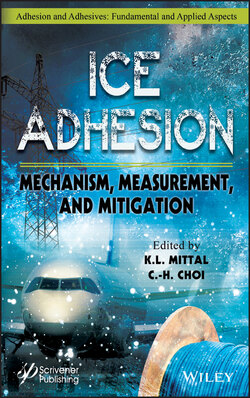Читать книгу Ice Adhesion - Группа авторов - Страница 19
1.2.4 Predicting Ice Nucleation Temperatures
ОглавлениеIn addition to determining the delay time for ice nucleation at a constant temperature, one can also determine experimentally and statistically the temperature at which the rate of critically-sized ice embryo formation becomes appreciable - the median nucleation temperature, TN.
Naturally, determination of a nucleation temperature involves decreasing the temperature of the studied system. If small changes in temperature, ∆T, are assumed around a reference temperature, T0, the free energy term in Equation 1.15 and the diffusion activation energy term in Equation 1.16 can be linearized according to Equations 1.21 and 1.22, respectively [78].
(1.21)
(1.22)
Equations 1.16, 1.21 and 1.22 can be inserted into Equation 1.15 to yield an approximation for the ice nucleation rate at the new temperature, given by Equation 1.23 [78].
(1.23)
where a and β are substrate-specific constants at temperature T0.
Experimentally, the nucleation temperature is the median temperature at which ice nucleates in a sessile water droplet placed on a studied surface when the entire liquid/surface/background gas system is cooled in a quasi-steady manner [75]. For ease of calculation, Equation 1.23 is best referenced to the experimental starting temperature, Ts, which is generally room temperature. For the change in temperature of ∆Ts around Ts, Equation 1.23 becomes Equation 1.24 [78].
(1.24)
where ∆T = Ts — T0 + ∆Ts. The value of as in Equation 1.24 is <<1. Further, because these experiments take place under quasi-steady cooling, ∆Ts can be described by a linear time relation, Equation 1.25
(1.25)
where α is the rate of temperature change per unit time.
As the temperature is continually decreased during experimentation aimed at the determination of the nucleation temperature, J(T) is no longer a constant. The rate of nucleation increases with decreasing system temperature. The Poisson point process in this scenario is nonhomogeneous as λ is a function of time. The nonhomogeneous Poisson distribution is given by Equation 1.26 [84].
(1.26)
where ζ and η are the bounds of the rate function λ(u). In the case of nucleation temperature determination, ζ = 0 and η = t, the length of time over which the change in nucleation rate takes place. Thus, the probability density function for the life-time of the liquid droplet under changing temperature conditions is given by Equation 1.27 [78, 85]
(1.27)
When integrated, Equation 1.27 yields the probability function of the frozen droplet, Equation 1.28.
(1.28)
Eberle et al. (2014) derive closed-form expressions for the nucleation temperature, TN, and the median freezing time, tmedian, by equating Equation 1.28 to 0.5 [78].
(1.29)
(1.30)
where T1 is the temperature at which the nucleation rate is equal to one embryo per second (i.e. J(T1) = 1 s–1). Note that the authors made use of the fact that (βα/as) >> 1 in deriving Equations 1.29 and 1.30. Equations 1.23 and 1.29 can be combined to determine the nucleation rate at the nucleation temperature, Equation 1.31.
(1.31)
